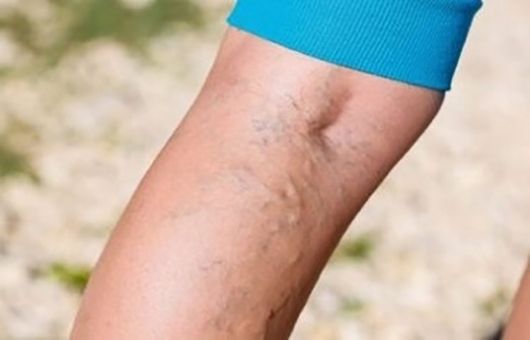All reviews about me are taken from Google. If you`d like to see real-world experiences from my treatment process, this feedback from my patients might give you some insight.
What Is Varicose Veins?
Varicose Veins
Varicose veins are enlarged and twisted superficial veins, most commonly seen in the lower extremities. They occur due to valve insufficiency and impaired blood return. Varicose veins are associated with chronic venous insufficiency and, if left untreated, can lead to leg pain, swelling, a feeling of heaviness, skin changes, and ulcers. Risk factors include age, female gender, pregnancy, obesity, prolonged standing, and genetic predisposition.

In the early stages of varicose vein disease, swelling may be observed due to vein enlargement. As the condition progresses, more prominent vein bulges can appear, and even ruptures in the veins may occur.
Although varicose veins initially usually cause cosmetic concerns, they can later lead to pain. If venous (vein) insufficiency develops, swelling occurs in the legs. If a clot forms in the varicose veins, it is called thrombophlebitis. Varicose veins can cause pain, swelling, and redness in the legs.
Varicose veins can occur in many parts of the body, but they are most commonly found in the legs. Therefore, when asking “what are varicose veins?” it usually refers to those in the legs.
Varicose Veins Are Venous Insufficiency!
Varicose veins are a result of insufficiency in the superficial veins of the legs, which are responsible for carrying deoxygenated blood back to the lungs for purification.
Deoxygenated blood from the legs is pumped back to the lungs with the help of various mechanisms. Valves in the leg veins prevent this blood from flowing backward due to gravity.
If the valves lose their function due to genetic or other factors, the blood sent to the lungs flows back under the influence of gravity (reflux) and accumulates in the leg veins. This leads to varicose veins, a condition that manifests itself with unwanted visible bulges, pain, discomfort, and swelling.
What Does Varicose Vein Mean?
When asked, “what does varicose vein mean?” it can be explained as the enlargement of leg veins and their inability to perform their function. The dilated veins cannot carry deoxygenated blood back to the heart. As a result, the veins behave like a plastic bag. The trapped blood inside the veins causes pain, aching, cramps, itching, and color changes.
What is Varicose Vein Disease?
Varicose vein disease refers to the same condition as varicose veins. It is the name given to the disease that occurs due to the enlargement of the leg veins. This vein enlargement in the legs can lead to circulation problems, which may result in blood clots. Therefore, varicose vein disease is an important condition that requires treatment.
Varicose veins are common and can be seen in many people. In most individuals, only a few signs of varicose veins appear, which means many patients may not even realize they have varicose veins.
Varicose vein disease can sometimes cause mild to moderate pain. In addition, it may lead to blood clot formation, and in advanced stages, varicose ulcers can develop.
Before treating varicose ulcers, the varicose veins themselves must be treated; otherwise, the ulcers will not heal without addressing the underlying veins.
Causes of Varicose Veins
There are many factors that contribute to the development of varicose veins. These include:
- Pregnancy
- Obesity
- Working while standing
- Prolonged standing
- Use of birth control pills
- Wearing tight clothing
- Chronic constipation
- Genetic predisposition
How Do Varicose Veins Begin?
The onset of varicose veins can be noticed as an increase in spider veins or the appearance of an enlarged vein in the leg. Additionally, pain and cramps may also indicate the presence of varicose veins.
Sometimes, patients seek medical attention solely because of cramps, without any other noticeable symptoms. If varicose veins are detected and treated early, the condition can be managed before it progresses further, preventing significant discomfort for the patient.
Stages of Varicose Veins
CEAP (Clinical Severity, Etiology, Anatomy, Pathophysiology) Classification
The CEAP classification was first developed by the International Committee of the American Venous Forum in 1994 and revised in 2004. The clinical component, denoted by the letter C, is scored from 0, representing completely asymptomatic patients, to 6, indicating an active ulcer.
The letters A or S added next to the C score indicate whether the patient is asymptomatic or symptomatic (e.g., CEAP 2S). In daily practice, often only the C score is used, while the E, A, and P scores are generally not applied.
This classification is very useful for examining the patient and grading disease severity, but it is not suitable for evaluating treatment response.
C (Clinical)
- C0: No visible signs (pain may be present)
- C1: Telangiectasias or reticular veins
- C2: Varicose veins
- C3: Venous edema
- C4: Trophic skin changes
- C5: Trophic changes with healed ulcer
- C6: Active ulcer
- A: Asymptomatic
- S: Symptomatic
E (Etiologic)
- EC: Congenital
- EP: Primary
- ES: Secondary
- EN: Unknown cause
A (Anatomic)
- AS: Superficial
- AP: Perforator
- AD: Deep
- AN: Not identified
P (Pathologic)
- PR: Reflux
- PO: Obstruction
Venous Clinical Severity Score (VCSS)
In this scoring system, nine main features of venous disease—such as skin changes, inflammation, pigmentation, induration, and the presence of ulcers—are scored from 0 to 3. This scoring system is more suitable for evaluating treatment response.
Varicose veins can develop gradually due to age and lifestyle, or they may appear suddenly. However, most varicose veins first present as spider veins.
When large and medium-sized varicose veins begin to form, an initial sign is often an increase in the number of spider veins. Therefore, when there is a noticeable increase in spider veins, the presence of underlying larger varicose veins should always be investigated.
If only spider veins are observed, treatment should not directly focus on them. If larger veins are present and the spider veins have developed as a result, treating the spider veins alone will inevitably lead to the appearance of new spider veins shortly thereafter.
Types of Varicose Veins
- Large Varicose Veins: These are prominent, bulging veins on the leg that are visible to the eye, with diameters ranging from 4 to 15 mm. Their scientific name is Varicose Vein.
- Medium-Sized Varicose Veins: These veins cause slight bulging on the surface of the leg, are usually bluish-green in color, and have diameters between 2 and 4 mm. Their scientific name is Reticular Vein.
- Spider Veins: These veins do not bulge from the skin surface but appear as a web-like pattern, red or purple in color, and smaller than 1–2 mm in diameter. Their scientific name is Telangiectasia.
What Are the Symptoms of Varicose Veins?
The most common symptoms of varicose veins include increased visibility of leg veins, vein enlargement and swelling, pain or aching, and in advanced stages, the formation of ulcers around the ankles. For a complete list of varicose vein symptoms, you can refer to our article on /varis-belirtileri.
Other symptoms may include:
- Pain, heaviness, burning sensation, throbbing, cramps, and swelling in the legs
- Bulging veins, bruising, "web-like" and spider veins
- Heaviness and aching in the legs
- Chronic fatigue
- Severe swelling
- Itching or irritation in the area of a varicose vein
- Presence of an ulcer near the ankle (indicating severe vascular pathology and requiring urgent attention).
What Are the Harms of Varicose Veins?
The harms of varicose veins arise from the accumulation and stagnation of deoxygenated blood within the veins. When blood pools in the leg veins, it leaks into surrounding tissues, impairing tissue nourishment.
Varicose veins can:
- Impair tissue nutrition
- Cause pain and aching
- Trigger cramps
- Lead to itching over time
- Cause varicose ulcers
- Promote clot formation within the vein
Much like a clogged sewer, waste begins to leak into surrounding areas. This results in aching, pain, cramps, and eventually itching over time.
The longer varicose vein treatment is delayed, the more likely discoloration and varicose ulcers will develop. Additionally, stagnant blood inside the vein tends to clot, so one of the harms of varicose veins is the formation of blood clots. Early treatment is therefore crucial.
Vascular diseases progress slowly and, if left untreated, can gradually lead to various complications:
- Edema (swelling)
- Sclerosis
- Skin pigmentation changes
- Thrombosis and bleeding
- Trophic ulcers
Varicose vein disease can sometimes lead to vein obstruction and even disability. In such cases, the concern is not merely aesthetic but protecting overall health. It should be remembered that treating varicose veins is easier in the early stages.
How Is Varicose Vein Treatment Performed?
The only effective treatment for varicose veins involves closing off the affected veins. Unfortunately, varicose veins cannot be treated externally with creams, medications, compression stockings, or even parasitic methods such as leeches.
In the past, varicose vein surgeries involved physically removing the affected veins. Today, however, varicose veins are treated and closed using modern methods, which will be described below.
How Can We Prevent Varicose Veins?
Varicose vein formation can be prevented by taking good care of our legs. This includes exercising regularly, maintaining a healthy diet, avoiding excessive weight gain, not standing for long periods, and avoiding prolonged inactivity. Varicose veins thrive in sedentary lifestyles and are more common in overweight and inactive individuals. Therefore, staying active is extremely beneficial.
- JJessica12.05.2022
I have varicose vein’s I need help! Where is your location ? How much? More information about please !!!
MD. Rengin TURKGULERhello, my staff will call you during the day for the treatment of varicose veins.
- NNoora Sultan16.04.2022
have problems with varicose veins and manifold varicose veins. I found the doctor’s account and saw a group of pictures in her account on Tok Tech and I would like to communicate with her because I am from Qatar and I want an appointment after Eid if possible, or send the address and phone of the clinic. Thank you
MD. Rengin TURKGULERHello, the authorized person will call you to give detailed information from the phone number you left.
 MD. RENGIN TURKGULER
MD. RENGIN TURKGULER

